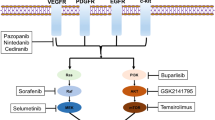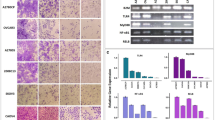Summary
The efficacy of tumor necrosis factor α (TNFα) as an anticancer agent is limited. This limitation might be related to the expression of a protein-synthesis-dependent resistance mechanism that prevents the lysis of tumor cells by TNFα. To test this possibility eight randomly selected human cell lines, three derived from ovarian carcinomas and five derived from cervical carcinomas, were tested for their in vitro sensitivity to TNFα-mediated lysis. The results of this analysis showed that all eight cell lines are normally resistant to lysis by TNFα. However, in the presence of inhibitors of protein synthesis, seven of them showed a significant increase in TNFα-mediated lysis. Measurement of protein synthesis showed that there is a linear correlation between the level of inhibition of protein synthesis and the level of TNFα-mediated lysis. The fact that seven of eight randomly selected cell lines are resistant to TNFα because they express a protein-synthesis-dependent resistance mechanism suggests that this mechanism of resistance may be common among gynecological cancers. The results also suggest that a therapy involving TNFα and inhibitors of protein synthesis might be useful for the treatment of gynecological malignancies.
Similar content being viewed by others
References
Aggarawal BB, Moffat B, Harkins RN (1984) Human lymphotoxin. J Biol Chem 259: 686
Blick M, Sherwin SA, Rosenblum M, Gutterman J (1987) Phase I study of recombinant tumor necrosis factor in cancer patients. Cancer Res 47: 2986
Carswell EA, Old LJ, Kassel RL, Green S, Fiore N, Williamson B (1975) An endotoxin induced serum factor that causes necrosis of tumors. Proc Natl Acad Sci USA 72: 3666
Collins JL, Patek PQ, Cohn M (1981) Tumorigenicity and lysis by natural killers. J Exp Med 153: 89
Collins JL, Kao M-S, Patek PQ (1987) Humans express natural cytotoxic (NC) cell activity that is similar to murine NC cell activity. J Immunol 138: 4180
Creaven PJ, Plager JE, Dupere S, Huben RP, Takita H, Mittelman A, Proefrock G (1987) Phase I clinical trial recombinant human tumor necrosis factor. Cancer Chemother Pharmacol 20: 137
Darzynkiewicz Z, Carter SP, Old LJ (1986) Effects of recombinant tumor necrosis factor on HL-60 cells: cell-cycle specificity and synergism with actinomycin D. J Cell Physiol 130: 328
DeFilippi P, Poupart P, Tavernier J, Fiers W, Content J (1987) Induction and regulation of m-RNA encoding 26-kDa protein in human cell lines treated with recombinant human tumor necrosis factor. Proc Natl Acad Sci USA 84: 4557
Fransen L, Van der Heyden J, Ruysschaert R, Fiers W (1986) Recombinant tumor necrosis factor: Its effects and its synergism with interferon-γ on a variety of normal and transformed human cell lines. Eur J Cancer Clin Oncol 22: 419
Friedman PA, Cerami A (1973) Actinomycin. In: Cancer medicine. Lea and Febiger, Philadelphia, p 835
Haranaka K, Satomi N (1981) Cytotoxic activity of tumor necrosis factor (TNF) on human cancer cells in vitro. Jpn J Exp Med 51: 191
Kimura K, Taguchi T, Urushizaki I, Ohno R, Abe O, Furue H, Hattori T, Ichihashi H, Inoguchi K, Majima H, Niitani H, Ota K, Saito T, Suga S, Suzuoki M, Wakui A, Yamada K (1987) Phase I study of recombinant human tumor necrosis factor. Cancer Chemother Pharmacol 20: 223
Kirstein M, Baglioni C (1986) Tumor necrosis factor induces synthesis of two proteins in human fibroblasts. J Biol Chem 261: 9565
Laster SM, Wood JG, Gooding LR (1988) Tumor necrosis factor can induce both apoptic and necrotic forms of cell lysis. J Immunol 141: 2629
Ortaldo JR, Mason LH, Herberman RB (1986) Relationship of mouse natural killer cells and mouse natural cytotoxic cells: effector cells and possible mechanism of action. Immunol Res 5: 25
Ortaldo JR, Mason LH, Mathieson BJ, Liang S-M, Flick DA, Herberman RB (1986) Mediation of mouse natural cytotoxic activity by tumor necrosis factor. Nature 321: 700
Patek PQ, Lin Y, Collins JL (1987) Natural cytotoxic cells and tumor necrosis factor activate similar lytic mechanisms. J Immunol 138: 1641
Ruggiero V, Latham K, Baglioni C (1987) Cytostatic and cytotoxic activity of tumor necrosis factor on human cancer cells. J Immunol 138: 2711
Scanlon M, Laster SM, Wood JG, Gooding LR (1989) Cytolysis by tumor necrosis factor is preceded by a rapid and specific dissolution of microfilaments. Proc Natl Acad Sci USA 86: 182
Sherman ML, Spriggs DR, Arthur KA, Imamura K, Frei E, Kufe DW (1988) Recombinant human tumor necrosis factor administered as a five-day continuous infusion in cancer patients: phase I toxicity and effects on lipid metabolism. J Clin Oncol 6: 344
Shirai T, Yamaguchi H, Ito H, Todd CW, Wallace B (1985) Cloning and expression inEscherichia coli of the gene for human tumor necrosis factor. Nature 313: 803
Sugarman BJ, Aggarwal BB, Hass PE, Figari IS, Palladino MA Jr, Shepard HM (1985) Recombinant human tumor necrosis factor-α: effects on proliferation of normal and transformed cells in vitro. Science 230: 943
Wang AM, Creasey AA, Ladner MB, Lin LS, Strickler J, Van Arsdell JN, Yamamoto R, Mark DF (1985) Molecular cloning of the complementary DNA for human tumor necrosis factor. Science 228: 149
Wong GHW, Goeddel DV (1988) Induction of manganous superoxide dismutase by tumor necrosis factor: possible protective mechanism. Science 242: 941
Wong GHW, Elwell JH, Oberley LW, Goeddel DV (1989) Manganous superoxide dismutase is essential for cellular resistance to cytotoxicity of tumor necrosis factor. Cell 58: 923
Author information
Authors and Affiliations
Rights and permissions
About this article
Cite this article
Powell, C.B., Mutch, D.G., Massad, L.S. et al. Common expression of a tumor necrosis factor resistance mechanism among gynecological malignancies. Cancer Immunol Immunother 32, 131–136 (1990). https://doi.org/10.1007/BF01754210
Received:
Accepted:
Issue Date:
DOI: https://doi.org/10.1007/BF01754210




